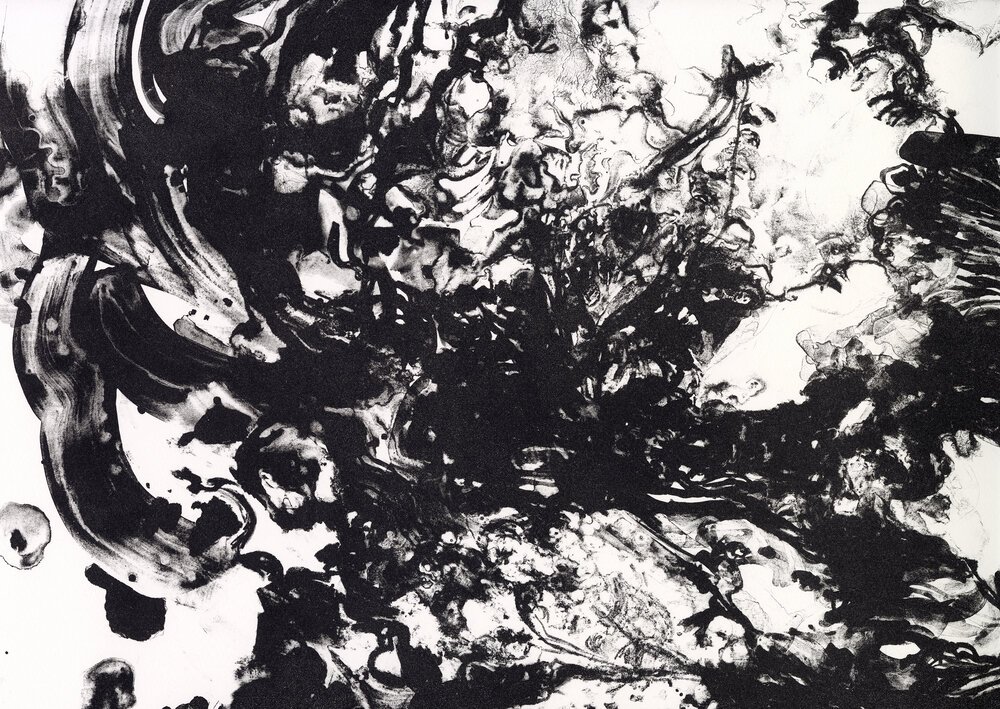
Kristina Kapeljuh
Kristina Kapeljuh’s prints bring to mind an overflowing stream carrying on its path the leaves and roots of an aged forest. They are both immense and miniature, and in the fragmentary effect of their contrasting details I indulge to wander with delight and fascination. Their disjointed and formless quality awakens my mind’s form-giving power. When one stares at them intently and for a while, they bud and sprawl out of the page and begin to mutter in the rare voices of a secret nature. It makes me wonder what we could see if we were able to detain for our eyes every moment of the world as it is during its transformation. What I see is the echo of a nature that is presently unknown, whose sole purpose is its becoming something else.
Many artists can make a great deal of the struggle between what is and what should be, and bring forth through their genius idols of perfection and passion; others charm by means of their peculiar naturalness, roaming in the backgrounds of vast landscapes, turning my mind towards the happiness of humble rooms or the light and darkness of curious skies. The young artist who by a chance encounter finds himself awed at the newness of the images he creates, alien to anything we know, and who awakes in the shock of spontaneity to the hidden enjoyment of his faculties, recognizes that there is something stultifying for the mind when our imagination coincides merely with our memory. Is this all? Aren’t there new objects we can offer to set the mind in motion? Like an alchemist pouring over essences, he learns to expect from his materials and luck new elixirs of life. But good art is rarely the product of dark magic. He needs to learn how to bring under his control the forces unleashed and exercise through judgement and craft what is at first the result of processes and fortune.
The future these pictures imagine is the experience of the unimaginable as normal; the unfolding of human perfectibility. Those who can envision “the chance meeting of a sewing machine and an umbrella on a dissecting table” know the spark that brightens the darkness of repetition and sameness; a light that the subject kindles to burst open the dullness of the whole. But “the illusionary pretense of making the soul speak directly is the weapon that rages in vain against the paper tiger of Enlightenment” (Calasso). Illusionary for the soul is part and parcel of that same whole, and even when it rages against it, it does it with its marks and colors. The enigmatic character of art cannot be a thin layer of varnish painted over an arrangement of shallower sights. It lies at its center, it is the eye that stares back from the feeling and purposiveness of each of the moments of the picture. What makes art enigmatic is what gives it quality, that strange sensation of an overpowering, unique and indissoluble, autonomous nature.
(from top to bottom)
Interobjectibity I, 2020, lithography on paper, 27x19 cm
Interobjectibity II, 2020, lithography on paper, 27x19 cm
Interobjectibity III, 2020, lithography on paper, 27x19 cm
Zinc, ice, acid, 2020, zinc plate with aquatint, 29x21 cm
Ice trace, 2020, aquatint etching on paper, 29x21 cm
Fragment loss, 2021, screen print on paper, 50x 35 cm
Fragment I, 2021, screen print on paper, 50x35cm
Nuclear, 2019, screen print on paper 30x30 cm
All rights are reserved. Digital copies of the prints are not for sale.
Kristina Kapeljuh was born in Ukraine, a citizen of Hungary, a student of Scotland, Switzerland, and finally, a practitioner in England.
You can see more of Kapeljuh’s work on her website and Instagram.
